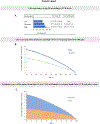Cardiovascular Health and Life Expectancy Among Adults in the United States
- PMID: 37036905
- PMCID: PMC10165723
- DOI: 10.1161/CIRCULATIONAHA.122.062457
Cardiovascular Health and Life Expectancy Among Adults in the United States
Abstract
Background: Cardiovascular disease may be the main reason for stagnant growth in life expectancy in the United States since 2010. The American Heart Association recently released an updated algorithm for evaluating cardiovascular health (CVH)-Life's Essential 8 (LE8) score. We aimed to quantify the associations of CVH levels, estimated by the LE8 score, with life expectancy in a nationally representative sample of US adults.
Methods: We included 23 003 nonpregnant, noninstitutionalized participants aged 20 to 79 years who participated in the National Health and Nutrition Examination Survey from 2005 to 2018 and whose mortality was identified through linkage to the National Death Index through December 31, 2019. The overall CVH was evaluated by the LE8 score (range, 0-100), as well as the score for each component of diet, physical activity, tobacco/nicotine exposure, sleep duration, body mass index, non-high-density lipoprotein cholesterol, blood glucose, and blood pressure. Life table method was used to estimate life expectancy by levels of the CVH.
Results: During a median of 7.8 years of follow-up, 1359 total deaths occurred. The estimated life expectancy at age 50 years was 27.3 years (95% CI, 26.1-28.4), 32.9 years (95% CI, 32.3-33.4), and 36.2 years (95% CI, 34.2-38.2) in participants with low (LE8 score <50), moderate (50≤ LE8 score <80), and high (LE8 score ≥80) CVH, respectively. Equivalently, participants with high CVH had an average 8.9 (95% CI, 6.2-11.5) more years of life expectancy at age 50 years compared with those with low CVH. On average, 42.6% of the gained life expectancy at age 50 years from adhering to high CVH was attributable to reduced cardiovascular disease death. Similarly significant associations of CVH with life expectancy were observed in men and women, respectively. Similarly significant associations of CVH with life expectancy were observed in White participants and Black participants but not in Mexican participants.
Conclusions: Adhering to a high CVH, defined as the LE8 score, is related to a considerably increased life expectancy in US adults, but more research needs to be done in other races and ethnicities (eg, Hispanic and Asian).
Keywords: CVD mortality; cardiovascular health; life expectancy.
Figures



References
-
- Tsao CW, Aday AW, Almarzooq ZI, Alonso A, Beaton AZ, Bittencourt MS, Boehme AK, Buxton AE, Carson AP, Commodore-Mensah Y, Elkind M, Evenson KR, Eze-Nliam C, Ferguson JF, Generoso G, Ho JE, Kalani R, Khan SS, Kissela BM, Knutson KL, Levine DA, Lewis TT, Liu J, Loop MS, Ma J, Mussolino ME, Navaneethan SD, Perak AM, Poudel R, Rezk-Hanna M, Roth GA, Schroeder EB, Shah SH, Thacker EL, VanWagner LB, Virani SS, Voecks JH, Wang NY, Yaffe K, Martin SS. Heart Disease and Stroke Statistics-2022 Update: A Report From the American Heart Association. Circulation. 2022;145:e153–e639. - PubMed
-
- Lloyd-Jones DM, Allen NB, Anderson C, Black T, Brewer LC, Foraker RE, Grandner MA, Lavretsky H, Perak AM, Sharma G, Rosamond W, American Heart Association. Life’s Essential 8: Updating and Enhancing the American Heart Association’s Construct of Cardiovascular Health: A Presidential Advisory From the American Heart Association. Circulation. 2022;146:e18–e43. - PMC - PubMed
-
- Stamler J, Stamler R, Neaton JD, Wentworth D, Daviglus ML, Garside D, Dyer AR, Liu K, Greenland P. Low risk-factor profile and long-term cardiovascular and noncardiovascular mortality and life expectancy: findings for 5 large cohorts of young adult and middle-aged men and women. JAMA. 1999;282:2012–2018. - PubMed
Publication types
MeSH terms
Grants and funding
LinkOut - more resources
Full Text Sources

